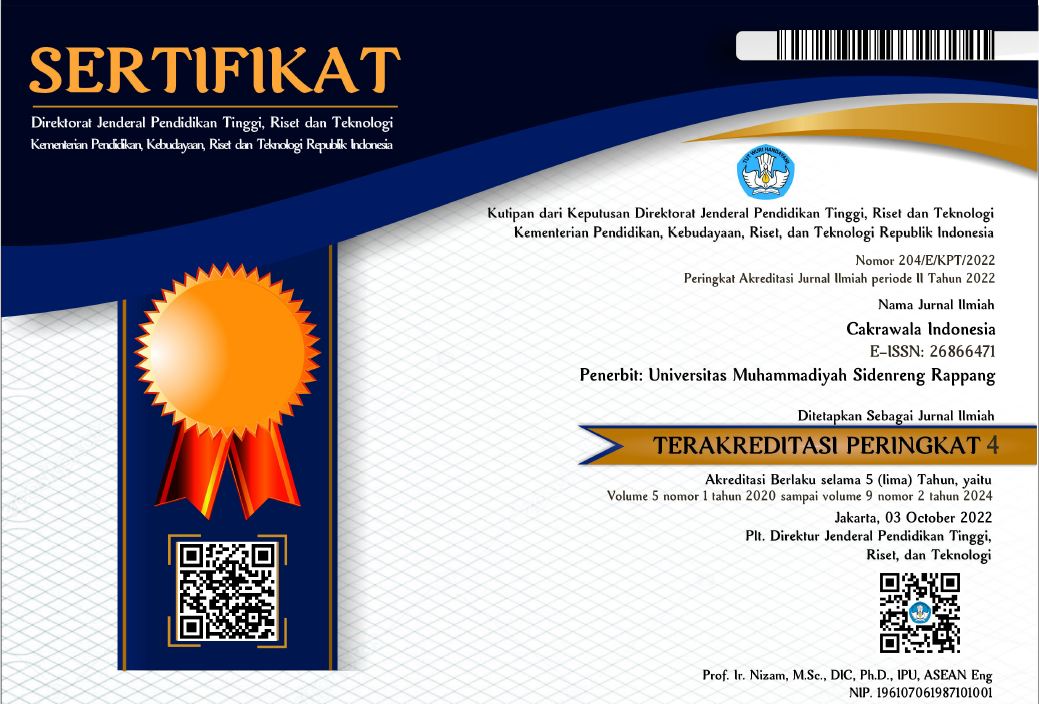THE USE OF YOUTUBE VIDEO BY NON-ENGLISH MAJOR STUDENTS FOR SPEAKING SKILLS
Abstract
This study was conducted to investigate the use of social media especially YouTube by students the Non-English Major of the Faculty of Economics at the University of Palangka Raya. It was also to see the impact of using social media especially YouTube to improve their speaking ability. The study design of this study was descriptive qualitative. Fifteen students of the Faculty of Economics were selected as participants to speak in front of a handphone camera with the topics already prepared. Five online meetings were done to know their progress. The Semi-structured interview was also done to collect the supporting data of deeper information needed. The result showed that the use of social media especially YouTube gave a high impact on the speaking ability of Non-English Major students as seen from their video and deep information from the interview. However, there was various resistance dealing with the efforts to increase their speaking ability, they are psychological factors (lessmotivated, not confident),environment factor (the relationship with their environment), linguistic factors (finding references, vocabulary selection, speaking style, and gesture). The use of social media especially YouTube might make the students feel easier in overcoming the various resistance to improve speaking ability.
References
Almurashi, W. A. 2016. The Effective Use of YouTube Videos for Teaching the English Language in Classrooms as Supplementary Material at Taibah University in Alula. International Journal of English language and Linguistics Research, 4(3), 32-47.
Asmani. 2011. Tuntunan Lengkap Metodologi Praktis Penelitian Pendidikan: Jakarta: Diva Press.
Casey, C. 1996. Incorporating cognitive apprenticeship in multi-media. Educational Technology: Research and Development, 44, 74-84. http://dx.doi.org/10.1007/BF02300327.
Chee, Y. C. 1995. Cognitive Apprenticeship and its application to the teaching of Smalltalk in a multimedia interactive learning environment. Instructional Science. 23, 133-161. http://dx.doi.org/10.1007/BF00890449.
Harmer, Jeremy. 2007. How to Teach English. England Longman.
Harris, David. 1974. Testing English as a Second Language. New York: McGraw-Hill Book Company
Helen G. & Mary Symons S. 1987. Speaking of Friendship: Middle-Class Women and Their Friends. Greenwood Press
Herdiansyah, H. 2009. Metode penelitian kualitatif untuk ilmu-ilmu social. Jakarta: Salemba Humanika.
Lee, C. S. et al. 2017. "Making sense of comments on YouTube Educational Videos: A self-directedlearning perspective". Online Information Review, 41(5), pp. 611-625. DOI: 10.1108/OIR-09 2016-0274
Manser, Martin H. 1995. Oxford Learners Pocket Dictionary. Oxford: Oxford University Press.
Miles, B. Matthew & Huberman, M. A. 1994. Qualitative Data Analysis 2nd Edition. International Educational and Professional Publisher. London: Sage Publications.
Nunan, D. 1999. Second Language Teaching & Learning. Boston: Newbury House Teacher Development.
Putra, N. 2012. Metode penelitian: kualitatif pendidikan. Jakarta: Raja Gra ndo Persada.
Richard, J. C. 1990. Curriculum Development in Language Teaching. New York: Cambridge
Sadtono, E. 1983. Penguasaan Bahasa Inggris Dosen di Indonesia. Pidato Pengukuhan Guru Besar, IKIP Malang
Shadiev, R, Hwang W. Y., & Liu, T. Y., 2018. Investigating the effectiveness of The learning activity supported by a mobile multimedia learning system to enhance autonomous EFL Learning in authentic contexts. Educational Technology Research and Development. 66(4), 893-912.
Sugiyono. 2016. Metode Penelitian Kuantitatif, Kualitatif, dan R&D. Bandung: PT. Alfabeta.
Sukarni. 2012. "Memanfaatkan YouTube sebagai media pembelajaran yang Interaktif, Menarik, dan Menyenangkan".
Watkins, J & Wilkins, M. 2011. Using YouTube in the EFL Classroom. Language Education in Asia 2(1), 113-119.
William, Brian & Sawyer, Stacey. 2015. Using Information Technology 11th Edition. McGraw-Hill Education.
Retained Rights/Terms and Conditions of Publication
As an author you (or your employer or institution) may do the following:
- Make copies (print or electronic) of the article for your own personal
- Every accepted manuscript should be accompanied by "Copyright Transfer Agreement" prior to the article publication






